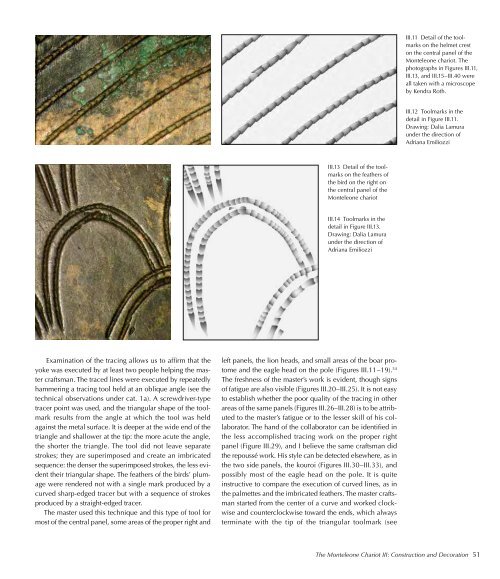Journal - Comune di Monteleone di Spoleto
Journal - Comune di Monteleone di Spoleto
Journal - Comune di Monteleone di Spoleto
Create successful ePaper yourself
Turn your PDF publications into a flip-book with our unique Google optimized e-Paper software.
examination of the tracing allows us to affirm that the<br />
yoke was executed by at least two people helping the master<br />
craftsman. The traced lines were executed by repeatedly<br />
hammering a tracing tool held at an oblique angle (see the<br />
technical observations under cat. 1a). a screwdriver-type<br />
tracer point was used, and the triangular shape of the toolmark<br />
results from the angle at which the tool was held<br />
against the metal surface. it is deeper at the wide end of the<br />
triangle and shallower at the tip: the more acute the angle,<br />
the shorter the triangle. The tool <strong>di</strong>d not leave separate<br />
strokes; they are superimposed and create an imbricated<br />
sequence: the denser the superimposed strokes, the less evident<br />
their triangular shape. The feathers of the birds’ plumage<br />
were rendered not with a single mark produced by a<br />
curved sharp-edged tracer but with a sequence of strokes<br />
produced by a straight-edged tracer.<br />
The master used this technique and this type of tool for<br />
most of the central panel, some areas of the proper right and<br />
iii.13 detail of the toolmarks<br />
on the feathers of<br />
the bird on the right on<br />
the central panel of the<br />
monteleone chariot<br />
iii.14 Toolmarks in the<br />
detail in Figure iii.13.<br />
drawing: dalia lamura<br />
under the <strong>di</strong>rection of<br />
adriana emiliozzi<br />
left panels, the lion heads, and small areas of the boar protome<br />
and the eagle head on the pole (Figures iii.11 – 19). 54<br />
The freshness of the master’s work is evident, though signs<br />
of fatigue are also visible (Figures iii.20 – iii.25). it is not easy<br />
to establish whether the poor quality of the tracing in other<br />
areas of the same panels (Figures iii.26– iii.28) is to be attributed<br />
to the master’s fatigue or to the lesser skill of his collaborator.<br />
The hand of the collaborator can be identified in<br />
the less accomplished tracing work on the proper right<br />
panel (Figure iii.29), and i believe the same craftsman <strong>di</strong>d<br />
the repoussé work. His style can be detected elsewhere, as in<br />
the two side panels, the kouroi (Figures iii.30 –iii. 33), and<br />
possibly most of the eagle head on the pole. it is quite<br />
instructive to compare the execution of curved lines, as in<br />
the palmettes and the imbricated feathers. The master craftsman<br />
started from the center of a curve and worked clockwise<br />
and counterclockwise toward the ends, which always<br />
terminate with the tip of the triangular toolmark (see<br />
iii.11 detail of the toolmarks<br />
on the helmet crest<br />
on the central panel of the<br />
monteleone chariot. The<br />
photographs in Figures iii.11,<br />
iii.13, and iii.15 – iii.40 were<br />
all taken with a microscope<br />
by Kendra roth.<br />
iii.12 Toolmarks in the<br />
detail in Figure iii.11.<br />
drawing: dalia lamura<br />
under the <strong>di</strong>rection of<br />
adriana emiliozzi<br />
The <strong>Monteleone</strong> Chariot III: Construction and Decoration 51


